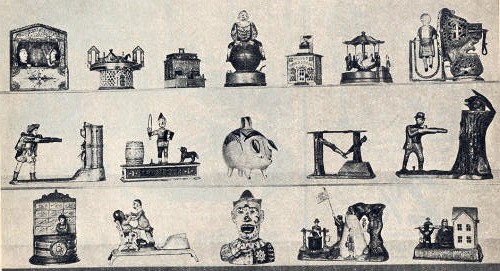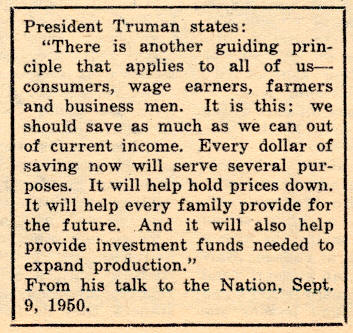September 24, 1950
(original is dated but no reference to its source)
Has the “PIGGY” Bank Gone For Good?

TODAY, you would
undoubtedly consider the mechanical banks given out by the savings banks
in the 1800's as amusing and ingenious devices. And, indeed, they were.
But, they represent a good deal more than that. These quaint gadgets
represent the birth of the spirit of thrift - a spirit that has grown and
spread through the years and contributed immeasurably to the happiness and
peace of mind of the American people.
To give you an idea of just how the spirit of thrift has snowballed
through the years, here are some interesting facts and figures about the
saving habits of the people of New York State. According to the 1950
census there are 14,700,000 people in New York State. And, out of that
great number, 7,500,000 are regular depositors in one or several of the
130 savings banks in the state. Plus this, there are 2,000,000 school,
Christmas and other special purpose accounts. The total amount of these
savings is $11.6 billions or $1,500 per account! The people of New York
City alone have saved $9.2 billions or an average of more than $1,100 for
each of the city's 8 million people. So you can see at a glance that
thrift is a by-word in the Empire State.
What makes people want to save and why in a savings bank? Many
"experts" believed that Social Security, unemployment benefits and
organized pension plans would make people feel that saving was unnecessary
because Uncle Sam would look out for them if anything happened and there
was always credit buying for the "extras". Well, the "experts" were wrong.
At the end of 1941 the Savings Banks of New York State had 6 million
accounts and $5.5 billions on deposit. Today, with government benefits
increased and pension plans even more widespread the number of savings
accounts is up 25% and the amount saved more than doubled.
WHY PEOPLE SAVE
So, what really does
make people want to save as the facts prove they do? Old age, sickness or
unexpected emergencies are the most often stated reasons for saving. But,
actually savings are used for more interesting and attractive purposes
— a new home, an automobile, a college
education, starting a new business or travel —
things that give enjoyment to the individual or family. These reasons give
the partial answer . . . but there's a deeper reason. Money in the savings
bank gives you a freedom and feeling of independence that is priceless.
Perhaps you will recall the movie "I Remember Mama" and the part her
mythical savings account played in the feeling of security and happiness
of her family. Jokes have been made about that "money in the bank" look.
This business of saving is a fundamental element of our country . . . as
American as baseball, apple pie and soda pop, the antithesis of Communism
and the socialistic state. That must be why more Americans are saving more
money today than ever before.
SAVINGS
BANKS MOST POPULAR
Now that it's more or less established why people save the question
naturally comes up why they save in a Savings bank and not in the mattress
or the much overworked tea pot. Most people answer this question quickly
and positively by saying, "You can always get your money when you want
it". Actually savings banks are so conveniently located that they're
almost as handy as the old-fashioned hideaway spots. Then people find
savings banks such friendly places in which to do business. Everyone right
up to the president is anxious to help, interested in your problems. Fact
is in most communities the bank people are busy, community minded
citizens, too. They feel they are servants of the community and have a
very real responsibility to it not only in the bank but in the affairs of
the town as well.
But, did you ever wish savings were not quite so easy to withdraw?
That's a criticism many bank people hear. You carefully map out a savings
program for yourself and then demon temptation puts something in your way
and out comes the money and it takes you just that much longer to reach
your goal. You'd be grateful if they made it hard in that case. But
supposing there was illness in the family and emergency funds were needed
immediately or a business opportunity arose where you needed quick cash.
It's a grand and glorious feeling to drop around at the bank and get the
money right away without red tape or penalty. This availability of your
money is a fundamental and carefully cherished principle of savings
banking.
But to discover the real reason savings banks enjoy the confidence
and support of every person in the community today let's flip back the
pages of the calendar and find out why and how savings banks were
organized. The first savings bank was started in 1819 as a place where
thrifty people could deposit their savings without fear of loss and where
it could work for them by earning interest. At the outset it was a simple
part-time operation where a small trunk was sufficient to hold cash and
vital records. The founders invested these savings by financing homes and
other improvements which would benefit the people of the community. But,
and this is a most important "but," the money was always invested in such
a way that the depositor could get it whenever he wanted. (Continued on
Page 15)
(Web
Note: Page 15 is missing, if you have a copy, please
share it by providing a copy to
MBCA webmaster.)



